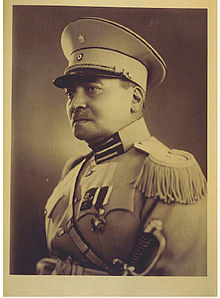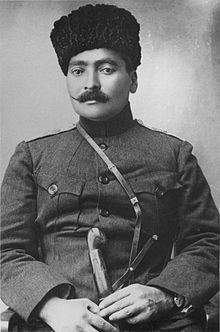- Assadollah Hosseinpoor
-
Colonel Assadollah Hosseinpour Born 1882/83
Tehran, IranDied 1954 Allegiance  Imperial State of Iran (Persia)
Imperial State of Iran (Persia)Years of service 1910-1942/43 Rank Colonel Unit Persian Cossack Brigade and Imperial Iranian Army Commands held See below Assadollah Hosseinpour (Persian: اسد الله حسین پور) was born in 1882/1883, in Tehran, Iran. He was one of Ahad Agha Shirvani’s three sons, and Moustafa Khan Shirvani’s grandson (Khan (i.e., governor of Shirvan)). Mustafa Khan Shirvani was a descendant from the Shirvan Shah who fought against Shah Esmaeil from the Persian Safavid dynasty. Following the defeat of the Shirvan Shah, the Khanate of Shirvan was annexed to Persia. However, Mustafa khan maintained the position of the governor of Shirvan even after annexation of the Khanate.
Assadollah Khan’s grandfather, Mustafa Khan, was a noble and powerful land owner who also held a high ranking military command in Shirvan. He married a Georgian princess while the khanates of Shirvan and Georgia were both parts of Persia. Georgia, Shirvan and 15 other provinces or territories were later annexed to Russia, after three Russo-Persian wars, during the Qajar dynasty.
Upon the separation of Shirvan and Georgia from Persia and their annexation to Russia; the patriot commanders in charge of the armies in both provinces, refusing to serve under the new Russian leadership, left their command posts and immigrated with their families to Persia. These two commanders remained loyal to the Shah of Persia and refused to serve under the Russian jurdistiction. Subsequently, the son of the Shirvan's commander married the daughter of the Georgian commander, who were Assadollah Khan Hosseinpour’s parents.
Contents
Military career
Assadollah Khan graduated in 1910 from the Persian Cossack Brigade Academy, representing its fourth graduating class. He was one of the highly educated and competent military officers in the Persian Cossack Brigade. Subsequently, He became a colleague and classmate to the future General Fazllollah Zahedi (future Prime Minister of Mohammad Reza Shah Pahlavi in 1953) and Colonel Mehdi Gholi Tajbakhsh. Upon graduation from the Academy, he performed his military mandates under Rouhoullah Mirza for about two years and was then appointed as the Commander to the Armies of the Provinces of Azerbaijan and Kurdestan in Iran. Assadollah Khan was later transferred to the Cavalry Division of the Persian Cossack Army and participated in the World War I (i.e., 1914), during which he held a rank of Lieutenant. At the end of the war, he was promoted to become a major. He was finally promoted to be a colonel after the successful Persian military coup of 1921 along with Reza Shah the Great and a number of other commanders and officers.
Colonel Hosseinpour has registered a significant and crucial role in the political arena of the contemporary Iran. His name has been documented in several Iranian government publications pertaining to his major involvements and achievements to facilitate political changes in Iran.
He, along with a number of other Cossack commanders, was the founding member of the new Imperial Iranian Armed Forces during the reign of Reza Shah (Pahlavi). Colonel Hosseinpour headed the Cavalry Division, in the February 21, 1921 coup headed by Reza Khan. He had a rank of major and was one of a number of officers who reached and secured Tehran. The city of Tehran was surrounded by a huge canal all around for protection against potential military invasion or rubbers. A tall wall also encircled the city including 12 huge metal gates. The gates would be locked at nights and protected by military guards. The military force headed by the coup officers left Karaj – a town about 40 km from Tehran – and arrived at the vicinity of one of the gates called Ghazvin Gate (i.e., close to the present Mehrabad International Airport). When major Hosseinpour reached the gate, he initiated conversation with the military officers guarding the gate, commanding that all other gates had already been secured and taken over and that it was in the best interests of the guards to surrender.
Subsequently, the guards surrounded and opened the gate. The army force then entered the city without any bloodshed and secured the capital. A few days later, Assadollah Khan Hossienpour was promoted to the rank of Colonel. He was also appointed (with the co-operation of a few other top military commanders) to convert and create the modern Imperial Iranian Army, Ground Forces, as the head of the Cavalry Division based at “Abbas Abad” Military Headquarter. A medal of military distinction called “Sevoum Hoot or Sevvoum Esfand” was subsequently awarded to the participating top ranking commanders and officers, around 1928.
Command Posts
Colonel Assadollah Khan Hosseinpour, throughout his military career, was appointed to a number of top military commands as follows:
- Commander of the Cavalry Division;
- Commander of the Army of the Province of Azerbaijan;
- Commander of the Army of the Province of Kerman;
- Commander of the Army of the Province of Kurdistan (in this post, he met the Governor General of The Province of Kurdistan named “Khuzaimeh A'lam” and later “Amir Asadollah A'lam”, the future Prime Minister and Court Minister to Mohammad Reza Shah Pahlavi. They shared a life long friendship);
- Head of the Imperial Iranian Army Judiciail Tribunal; and
- Chief Military Advisor to the Imperial Iranian Ground Forces.
Military Medals
The following are amongst a few of medals of military distinction he was awarded:
- Coup of the Sevvoum Esfand Medal;
- Sepah Medal; and
- Zoulfaghar Medal.
Colonel Hosseinpour retired from the Imperial Iranian Army at the age of around 60 and was involved in monitoring the affairs of his villages, estates and philanthropic activities, for the remainder of his life.
Personal life
Assadollah khan’s father who lost his parents and his brother at a young age inherited all the wealth and the estates of the family. The Iranian government granted the ownership of a number of estates, farms, parcels of land and villages to him as well as a few other top commanders, to compensate their fathers for their financial losses, due to imigration to Persia. Asadollah khan family’s portion included numerous villages, farms, estates, large parcels of land and houses which were eventually inherited by young Colonel Hosseinpour.
Assadollah Khan’s grandfather was Amir Hossein, a prominent high ranking commander of Shirvan and a close colleague and friend of Pasha Khan Pashai. He participated and fought along Colonel Pasha Khan, against the Russian Army, in the war of 1863. Pasha Khan devoted a lot of efforts to develop a farm named “Koushk-e Mir Hossein”, which was named after either Assadollah Khan’s grandfather or his own grandfather.
Amir Hossein married the daughter of one of the landlords of Saraband territory in the Township of Arak, Iran. Assadollah Khan’s grandmother therefore is from Arak. All the wealth (villages and large parcels of land) of this lady was inherited by Assadollah Khan as well.
Assadollah Khan lost his mother at the age of 12. His sister was married to Abdoullah Mostoufi, who was the governor of the Town of Arak. Later, he lost his sister at a young age as well. His grand father, “Amir Hossein”, was an extremely generous and famous individual who enjoyed a wealthy noble lifestyle. Assadollah Khan’s father’s uncle (Pashai), persuaded him to join the Persian Cossack Brigade Academy.
At the age of 20, he inherited from his father and lived an aristocrat life. He frequently visited the Pashai’s house to visit his cousins, while attending the Persian Cossack Brigade Academy, as a student. It was quoted by Mrs. Pashai that in 1906 when Assadollah Khan visited her and her husband, he was still a military student at the Academy. He was a very handsome, well- groomed, educated, noble gentleman who would ride a horse from “Poule (bridge) Amir Bahadour” where he lived; while escorted by a military guard.
Assadollah Kahn Married Badieh Khanum Monadjemi. She, despite her youth, had attained a special social, political, cultural and religious status (religious referring to her belief and adherence to the Bahá’í Faith). Her ancestors had confirmed their beliefs in the then Báb’i faith, for more than 3 generations.
Assadollah Khan and Badieh Khanum’s first child was a daughter, named Fakhralzaman Khanum. A few years after Fakhralzaman Khanum was born, her mother gave birth to a baby boy, named Amir Houshang. Amir Houshang, however, died a few years after birth.
A few years after Badieh khanum died due to breast cancer, Colonel Hosseinpour married his 2nd wife, Monireh Khanum (Badieh Khanum’s sister). This marriage produced three daughters (Tourandokht, Pourandokht, and Victoria), and two sons (Abdolreza and Tooraj).
Monireh Khanum died in her sleep at the age of 48. Four years later, Assadollah Khan Hosseinpour also died due to a heart attack in 1954, in Iran. He was buried in the Bahá’í's cemetery of Tehran (i.e., Golestaneh Javid) which was later destroyed by the Islamic thugs and their mobs, after the socio-political unrest of 1979, in Iran.
References
- Alireza Sari. Biography and Ancestral backgrounds of Fakhralzaman Khanum Hosseinpour, Aligholi Khan Sari, Colonel Assadollah Khan Hosseinpour Published=2008.
- Ahmad Bani-Ahmad. Tarigh Shahanshah Pahlavi (His Majesty Rezā Shāh the Great). 3. Imperial Iranian Army Press.
Categories:- Iranian military commanders
- 1954 deaths
Wikimedia Foundation. 2010.





